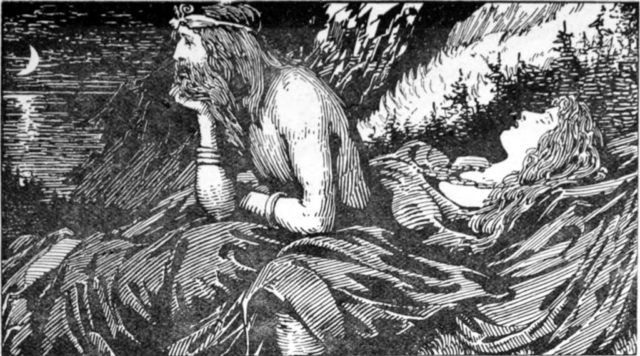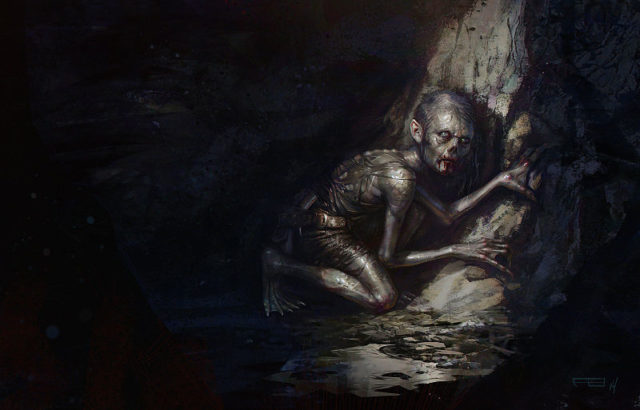Currently, there are several Roman rings of silver and gold in archives and museums.
But one Roman ring stands out as legendary – the ring known as the Ring of Senicianus, the Vyne Ring, or the Ring of Silvianus.
This gold ring was stolen about 1,600 years ago. The owner had begged the gods to curse the thief and any other person who possessed it.
Owned now by the National Trust and on display at Vyne Manner, this golden ring might have been the inspiration for J.R.R Tolkien’s ring in The Hobbit.

Sometime during the 4th century AD, Silvianus, a Roman who was stationed in Gloucestershire in England, visited the elaborate baths of the Celtic God Nodens. This was located on a hill above the River Severn at Lydney.
The Temples of Nodens had celebrated the Roman and British god connected with the sea, dogs, hunting, and dealing.
Nodens is the original word of the Old Irish deity, Nuada Airgetlam. The first king of the Tuatha de Danann, who was ineligible from ruling Ireland for the reason that he lost his hand during a battle, has been linked with the Fisher King of Arthurian legends, the Norse god Vanir Njord, and the Roman god Mars.
When Silvianus was at the Temple, his golden ring was taken from him. Silvianus thought it was Senicianus who had stolen the ring, but how he would have known that is not clear.
Silvianus, therefore, went to the Temple and created a lead plate known as the defixio, or the curse tablet.
He engraved the tablet in Latin:
“DEVO NODENTI SILVIANVS ANILVM PERDEDIT DEMEDIAM PARTEM DONAVIT NODENTI INTER QVIBVS NOMEN SENICIANI NOLLIS PETMITTAS SANITATEM DONEC PERFERA VSQVE TEMPLVM DENTIS”
In English, this translates as “For the god Nodens. Silvianus has lost a gold ring and is donating one-half of its worth to Nodens. Of the man called Senicianus, permit no good health upon him until the ring is returned back to the temple of Nodens.”
The ring is big, possibly meant to be worn outside of a glove or on the thumb. It is one inch in diameter and weighs about twelve grams.
The ring’s comprised of ten facets and a square bezel that was engraved with the picture of the Roman goddess Venus. When the pagan Silvianus had the ring, the ten gold sides were bare.
The later Christian owner, perhaps Senicianus, had the ring crudely engraved with the words “SENICIANE VIVAS IIN DE”. Most likely the inscriber had meant to say “SENICIANE VIVAS IN DEO” or “Senicianus, might you live with God”. Or else he did not spell “IN” correctly, with two Is, and then had no room for the O in the word DEO.
Not much is known about the fate of Senicianus.
The ring was found in the year 1785, discovered in a plowed field located on a farm that was close to Silchester, England. Silchester is a town of Roman origin around 100 miles (160 km) away from Lydney.

Several researchers state that the ring had been accidentally lost. Some others believe that it was intentionally discarded. The Silchester farmer was in hard times, so the ring was sold to the Chute family.
They lived in a close country house, The Vyne. The Chutes were noted to be intrigued by history and antiquities.
But it was not until the year of 1888 that Chaloner Chute noticed the ring and had its existence published in the paper.
It was not until 1929 that the link made between the Silvianus curse tablet and the Vyne Ring by the archaeologist Sir Mortimer Wheeler.
The relationship cannot be entirely confirmed, although Senicianus is an uncommon name and the close dates of the artifacts appear to support Wheeler’s theory.
At this time, J.R.R Tolkien was just a professor of Celtic and Anglo-Saxon literature at Oxford University.
He was asked by his friend Wheeler to help shed light on who the god Nodens was and what role he may have played in the history of the Ring.
Several now have faith that the Ring of Senicianus was the muse for the ring in the book The Hobbit.
There was an article published in History Today, in which Mark Horton, a professor of Archaeology at the University of Bristol, and Dr. Lynn Forest Hill, an Education Officer for the Tolkien Society, both explain that Silvianus lost his gold ring at Lydney and Gollum had lost his under the Misty Mountains. Silvianus had faith that his ring was stolen by Senicianus and Gollum thought his ring was stolen by Bilbo Baggins.
Silvianus cursed the name of the person he suspects. As Gollum figured out that Bilbo discovered and kept his ring, he cried out in rage, “Thief, thief, thief! Baggins! We hates it; we hates it, we hates it forever!”
Both Silvianus and Gollum had known the identity of the person they viewed as thieves who had stolen their gold rings. Both had declared these names with a curse, Ancient Origins reported.

It is significant to recall that the ring in The Hobbit, written in the year of 1937, gave the wearer the ability to be invisible.
Yet in The Lord of the Ring books that were written in 1954-55, it gave the person who wore the ring untold power, extended life, and unique sight.
The author J.R.R Tolkien acknowledged the difference; he wrote: “The only liberty … has been to make Bilbo’s Ring the One Ring: all rings had the same source before ever he put his hand on it in the dark.”
